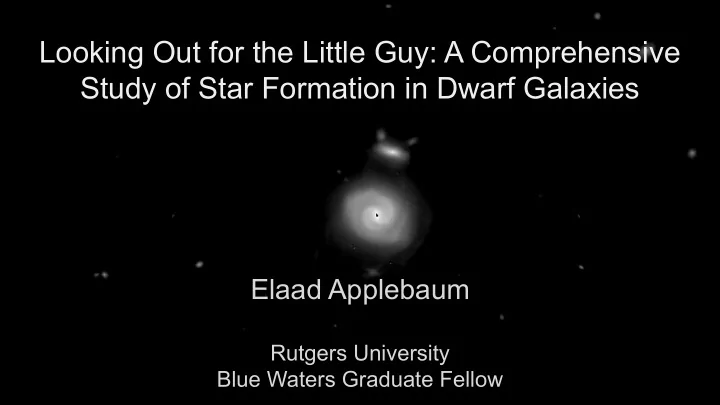

Looking Out for the Little Guy: A Comprehensive Study of Star Formation in Dwarf Galaxies Elaad Applebaum Rutgers University Blue Waters Graduate Fellow
A Few Open Questions ● How big are the smallest galaxies (is there a “smallest” galaxy)? ● How many nearby galaxies are there? ● How do stars form from gas within galaxies? ● Why do galaxies stop forming new stars? ● Can we explain the diversity of galaxy properties we observe? ● …
A Few Open Questions ● How big are the smallest galaxies (is there a “smallest” galaxy)? ● How many nearby galaxies are there? ● How do stars form from gas within galaxies? ● Why do galaxies stop forming new stars? ● Can we explain the diversity of galaxy properties we observe? ● … *And what conclusions can we safely draw from our simulations?
Galaxy Formation ● Most (~85%) matter is dark matter ● Initial density perturbations grow under the influence of gravity ● Gas condenses in dark matter “halos”, where it eventually forms the first galaxies ● Over time, halos accrete and merge, forming the systems we see today
Galaxy Formation Credit: Via Lactea simulation Diemand+ 2007
Galaxy Formation ● Gravity + hydrodynamics ● Initially dark matter and gas, then stars form ● Star formation, supernovae, mass and radiation from massive stars all modeled as “sub-grid” recipes
Laissez Faire Galaxies? ● Galaxy “self-regulation” obscures the underlying mechanisms of star formation and feedback ● Constraining the details requires studying a regime that cannot self-regulate ● Dwarf and ultra-faint dwarf galaxies Benincasa+ 2016
M100 (Distance ~ 50 Mly) Credit: ESO
Eridanus II Horologium I (Distance ~ 1 Mly) (Distance ~ 300 kly) Credit: V. Belokurov, S. Koposov (IoA, Cambridge)
Recap We want to study very small galaxies, in large enough numbers to draw conclusions about different star formation models, in a fully cosmological context We need very high-resolution, cosmological hydrodynamic simulations
Why We Need Blue Waters Scale → Small Big ↓ >10 8 ly Spatial 10s of ly (Hydrodynamics (gravitational and gravity torques and forces) resolutions) >10 10 yr Temporal 100s of yr (force calculations) (age of Universe)
Why We Need Blue Waters Scale → Small Big ↓ Star formation, supernovae, >10 8 ly Spatial 10s of ly stellar mass loss << resolution (Hydrodynamics (gravitational and gravity torques and forces) resolutions) >10 10 yr Temporal 100s of yr (force calculations) (age of Universe)
ChaNGa: A Modern Cosmological SPH Code ● Includes the SPH methods and physics modules of GASOLINE2 ● Uses CHARM++ runtime system ● Designed for scalability on massive parallel systems like Blue Waters https://nbody.shop Menon+ 2015, Wadsley+ 2017
Model Comparisons Star Formation Models: Environments: ● “Metal Cooling (MC)” ● Far from the Milky Way (>15 Mlyr from ○ Density threshold (100 m H cm -3 ) in cold Milky Way, in an “isolated” environment) (<10 4 K) gas ● Near (analogous to) the Milky Way ● “Molecular Hydrogen (H 2 )” ○ At cutting-edge resolution! ○ Requires sufficient H 2 gas to form stars ■ 87 parsec gravitational softening, 11 ○ Tracks non-equilibrium H 2 abundance pc hydro smoothing ○ Pushes star formation to higher densities ■ 994 Msun initial star particle mass in un-enriched gas ■ 3310 (17900) initial gas (dark matter) particle mass See also, e.g., Agertz+ 2019
Results Far From the Milky Way Increasing Galaxy Luminosity Increasing Galaxy Luminosity Munshi...EA..+ 2019
Results Far From the Milky Way Applebaum+ in prep
Results Near the Milky Way Surprisingly, there is little difference between star formation models! MW2 MW1 Applebaum+ in prep
Summary ● Cosmological hydrodynamic simulations are probing for the first time analogs to the faintest known galaxies ● At low enough halo masses, self-regulation breaks down, and we can test the assumptions used in cosmological simulations ● In environments far from the Milky Way, we have shown that different star formation criteria lead to diverging results ● Near the Milky Way, the denser environment leads to converged galaxy counts and locations. Caution is needed when interpreting nearby observations using simulations of isolated environments https://nbody.shop applebaum@physics.rutgers.edu emapple
Acknowledgments Thank you to Robert Brunner, Scott Lathrop and the entire Blue Waters team for their assistance and support during the Blue Waters Graduate Fellowship. https://nbody.shop applebaum@physics.rutgers.edu emapple
Recommend
More recommend